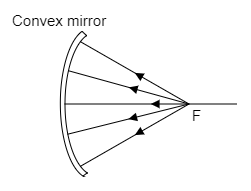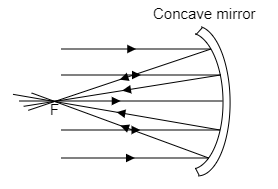
State that the following statement is true or false,
A ray of light parallel to the principal axis, after reflection, will pass through the principal focus.
(A) True.
(B) False.
Answer
550.2k+ views
Hint: The light rays that pass through the straight line can only be reflected by two types of mirror. They are convex mirrors and concave mirrors. The concave mirror is a mirror that is curved inward and the convex mirror is curved outward.
Complete solution:
Convex mirror:
As we know that the convex mirror is outwardly curved in which the light rays that travel in a straight line hit the surface of the mirror, then the reflected light rays diverge from the principal axis. The principal axis is nothing but the straight line that passes through the centre of the spherical mirror, that is it passes through the centre of curvature of the mirror. Since, the parallel light rays that get reflected from the convex mirror get diverged, the reflected light rays do not pass through the principal focus.

Concave mirror:
We know that the concave mirror is an inward curved mirror in which the light rays that travel parallel to the principal axis when hits the reflecting surface of the mirror, the reflected ray gets converged towards the principal axis. The converged rays then pass through the principal focus of the mirror. The point where the incident rays of the light gets focused is called the principal focus.

Therefore, the light ray parallel to the principal axis, after reflection, will pass through the principal focus.
Hence, the option (A) true is the correct answer.
Note: The nature of the image that is formed due to the object varies from one mirror to the other. The nature of the image that is formed due to a convex mirror is virtual and erect, virtual means the image is nearly or more or less as detailed as the object and erect means the image formed is upright or straight. The nature of an image formed in a concave mirror is real and inverted, real means the image that formed is not an imitation or artificial but it looks exactly as that of the image and inverted means the image formed is upside down.
Complete solution:
Convex mirror:
As we know that the convex mirror is outwardly curved in which the light rays that travel in a straight line hit the surface of the mirror, then the reflected light rays diverge from the principal axis. The principal axis is nothing but the straight line that passes through the centre of the spherical mirror, that is it passes through the centre of curvature of the mirror. Since, the parallel light rays that get reflected from the convex mirror get diverged, the reflected light rays do not pass through the principal focus.

Concave mirror:
We know that the concave mirror is an inward curved mirror in which the light rays that travel parallel to the principal axis when hits the reflecting surface of the mirror, the reflected ray gets converged towards the principal axis. The converged rays then pass through the principal focus of the mirror. The point where the incident rays of the light gets focused is called the principal focus.

Therefore, the light ray parallel to the principal axis, after reflection, will pass through the principal focus.
Hence, the option (A) true is the correct answer.
Note: The nature of the image that is formed due to the object varies from one mirror to the other. The nature of the image that is formed due to a convex mirror is virtual and erect, virtual means the image is nearly or more or less as detailed as the object and erect means the image formed is upright or straight. The nature of an image formed in a concave mirror is real and inverted, real means the image that formed is not an imitation or artificial but it looks exactly as that of the image and inverted means the image formed is upside down.
Recently Updated Pages
A man running at a speed 5 ms is viewed in the side class 12 physics CBSE

The number of solutions in x in 02pi for which sqrt class 12 maths CBSE

State and explain Hardy Weinbergs Principle class 12 biology CBSE

Write any two methods of preparation of phenol Give class 12 chemistry CBSE

Which of the following statements is wrong a Amnion class 12 biology CBSE

Differentiate between action potential and resting class 12 biology CBSE

Trending doubts
What are the major means of transport Explain each class 12 social science CBSE

Which are the Top 10 Largest Countries of the World?

Draw a labelled sketch of the human eye class 12 physics CBSE

How much time does it take to bleed after eating p class 12 biology CBSE

Explain sex determination in humans with line diag class 12 biology CBSE

Explain sex determination in humans with the help of class 12 biology CBSE




